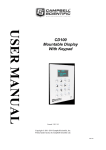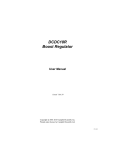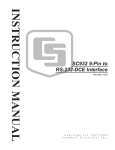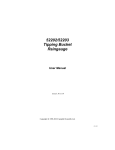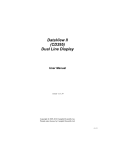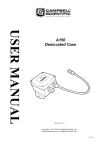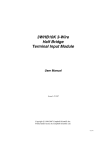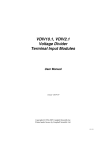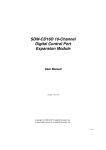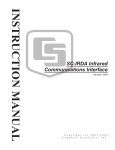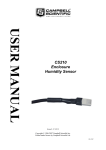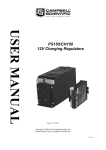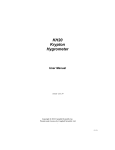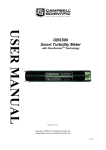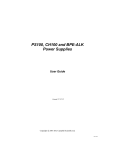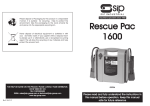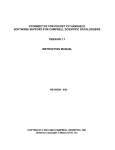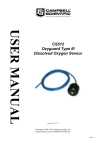Download A100R Switching Anemometer - Bad Request
Transcript
A100R Switching Anemometer User Manual Issued 16.3.10 Copyright © 2010 Campbell Scientific Ltd CSL 15 Guarantee This equipment is guaranteed against defects in materials and workmanship. This guarantee applies for twelve months from date of delivery. We will repair or replace products which prove to be defective during the guarantee period provided they are returned to us prepaid. The guarantee will not apply to: • Equipment which has been modified or altered in any way without the written permission of Campbell Scientific • Batteries • Any product which has been subjected to misuse, neglect, acts of God or damage in transit. Campbell Scientific will return guaranteed equipment by surface carrier prepaid. Campbell Scientific will not reimburse the claimant for costs incurred in removing and/or reinstalling equipment. This guarantee and the Company’s obligation thereunder is in lieu of all other guarantees, expressed or implied, including those of suitability and fitness for a particular purpose. Campbell Scientific is not liable for consequential damage. Please inform us before returning equipment and obtain a Repair Reference Number whether the repair is under guarantee or not. Please state the faults as clearly as possible, and if the product is out of the guarantee period it should be accompanied by a purchase order. Quotations for repairs can be given on request. When returning equipment, the Repair Reference Number must be clearly marked on the outside of the package. Note that goods sent air freight are subject to Customs clearance fees which Campbell Scientific will charge to customers. In many cases, these charges are greater than the cost of the repair. Campbell Scientific Ltd, Campbell Park, 80 Hathern Road, Shepshed, Loughborough, LE12 9GX, UK Tel: +44 (0) 1509 601141 Fax: +44 (0) 1509 601091 Email: [email protected] www.campbellsci.co.uk PLEASE READ FIRST About this manual Please note that this manual was originally produced by Campbell Scientific Inc. primarily for the North American market. Some spellings, weights and measures may reflect this origin. Some useful conversion factors: Area: Length: 1 in2 (square inch) = 645 mm2 1 in. (inch) = 25.4 mm 1 ft (foot) = 304.8 mm 1 yard = 0.914 m 1 mile = 1.609 km Mass: 1 oz. (ounce) = 28.35 g 1 lb (pound weight) = 0.454 kg Pressure: 1 psi (lb/in2) = 68.95 mb Volume: 1 UK pint = 568.3 ml 1 UK gallon = 4.546 litres 1 US gallon = 3.785 litres In addition, while most of the information in the manual is correct for all countries, certain information is specific to the North American market and so may not be applicable to European users. Differences include the U.S standard external power supply details where some information (for example the AC transformer input voltage) will not be applicable for British/European use. Please note, however, that when a power supply adapter is ordered it will be suitable for use in your country. Reference to some radio transmitters, digital cell phones and aerials may also not be applicable according to your locality. Some brackets, shields and enclosure options, including wiring, are not sold as standard items in the European market; in some cases alternatives are offered. Details of the alternatives will be covered in separate manuals. Recycling information At the end of this product’s life it should not be put in commercial or domestic refuse but sent for recycling. Any batteries contained within the product or used during the products life should be removed from the product and also be sent to an appropriate recycling facility. Campbell Scientific Ltd can advise on the recycling of the equipment and in some cases arrange collection and the correct disposal of it, although charges may apply for some items or territories. For further advice or support, please contact Campbell Scientific Ltd, or your local agent. Campbell Scientific Ltd, Campbell Park, 80 Hathern Road, Shepshed, Loughborough, LE12 9GX, UK Tel: +44 (0) 1509 601141 Fax: +44 (0) 1509 601091 Email: [email protected] www.campbellsci.co.uk Contents PDF viewers note: These page numbers refer to the printed version of this document. Use the Adobe Acrobat® bookmarks tab for links to specific sections. 1. Specifications .............................................................. 1 2. Mounting....................................................................... 2 3. Connection to Datalogger ........................................... 2 4. Programming the Datalogger ..................................... 3 4.1 Example Program for CRBasic data loggers ............................................ 3 4.2 Example Program for Edlog data loggers ................................................. 4 5. Replacement of Bearings ............................................ 5 Appendix A. Fitting and Using the HE-1 De-icing Heater .......... A-1 Figures 1. A100R Anemometer – Sectional View ...................................................... 6 Tables Instruction 3 Multipliers for Different Execution Intervals with Option 12 ...................................................................................................... 4 i A100R Switching Anemometer The A100R anemometer is a precision instrument which is easily interfaced with Campbell Scientific dataloggers to give accurate measurements of wind run or mean wind speed. A magnet turns with the rotor spindle producing a varying field which causes a mercury-wetted reed switch to make and break contact once per revolution of the rotor. The contacts are bounce free, and no power is required apart from that necessary to detect contact closure; the A100R is thus well suited for use on remote sites. The rotor is tested by comparison with a rotor calibrated at the National Physical Laboratory, and a calibration figure is provided with each instrument. The anemometer is constructed from anodised aluminium alloy, stainless steels and weather resisting plastics. A stainless steel shaft runs in two precision, corrosion-resistant ball-races. The bearings are protected from the entry of moisture droplets and dust, resulting in an instrument suitable for permanent exposure to the weather. In the marine version (A100R3, available to special order) a touching shaft-seal is fitted for extra protection in place of the standard non-contact seal; please note that this gives a small increase in the threshold speed. An optional anti-icing heater can be fitted if required (see Appendix A). 1. Specifications Threshold Speed: 0.25ms-1 (0.6ms-1 A100R3) Max. speed: Accuracy: Distance Constant: Calibration: Temp. Range: Size: Rotor: Weight: Fixing: Greater than 75ms-1 l% ±0.1ms-1 5m 0.80 revolutions per metre (1 pulse per 1.25 metres)* -30°C to +55°C Height 200mm, case diameter 55mm, attached cable 3m Standard 150mm diameter 3-cup rotor 350g including standard cable Rotor: Patented gravity sensitive fastener for rapid attachment and release. Anemometer: Standard tripod screw (1/4" BSW/UNC), taper adapter also available. Note that mounting must be within 15° of vertical. Switching Voltage: 100V DC max. Switching Current: 0.5A max. Switch Rating: 28W max. (DC resistive) Duty Cycle: 50% ±5% up to 50ms-1 ±10% up to 75ms-1 Contact Resistance: 0.05Ω Actuating Time: l.5ms Switch Bounce: NIL Min. Current: NIL (life not reduced by use in dry circuits) Switch Life: Rated 25 x 109 operations minimum Electrical: * See the individual rotor calibration sheet (and when a heater is fitted Appendix A) for minor corrections to the nominal figure. 1 A100R Switching Anemometer 2. Mounting 1. To attach the rotor, remove the white protector tube, hold the anemometer slightly out of vertical and lightly push on the rotor until positive location is obtained. Take care not to damage the cups. (To remove the rotor, first turn the instrument upside down and press upwards to release a gravity sensitive catch within the hub which will then slide off.) CAUTION Avoid excessive force, and take care not to damage the cups. NOTE The A100R rotor is not interchangeable with the rotor from any other model of Vector Instruments anemometer. NOTE 2. Mount the anemometer using a 1/4" BSW screw into the base. A 6° taper mounting is available as an alternative for portable applications. 3. Mount the instrument vertically to ensure accurate results and a long operational life. Do not operate when the instrument is inclined at more than 15° from the vertical. Bearing wear increases significantly if the anemometer is not properly levelled This instrument contains a magnetic reed switch, partly filled with mercury. If subject to shock or vibration during transit, the mercury tends to become distributed in globules which may prevent correct operation of the instrument. To rectify, hold the anemometer approximately vertical and shake downwards firmly and sharply. This will drive the mercury back into its reservoir and force the globules together. 3. Connection to Datalogger Contact closure is between the yellow and green wires; the blue and red wires are not used. Connect the green wire to one of the pulse counting channels on your datalogger and connect the yellow wire to power ground (see note below). It is also advisable to connect the screen to ground at the datalogger. 2 User Manual NOTE Power ground is marked ‘G’ on the CR200, CR800, CR850, CR1000, CR3000, CR5000, CR23X, CR10/10X and CR510, and on the 21X and CR7 dataloggers. 4. Programming the Datalogger Anemometers of the switching (or ‘contact closure’) type such as the A100R are measured with the Pulse Count instruction configured for Switch Closure. Output is required as a wind speed in units of ms-1. The nominal calibration of the A100R is such that 1ms-1 corresponds to 0.8 pulses/sec*; if the likely maximum wind speed is 10ms-1, then the maximum pulse rate from the anemometer will be 8.0 pulses/sec. 4.1 Example Program for CRBasic data loggers `CR1000 `Example program showing measurement of a single A100R sensor every 2 seconds. `Declare Variables and Units Public BattV Public WS_ms Units BattV=Volts Units WS_ms=metres/second `Define Data Tables DataTable(Table2,True,-1) DataInterval(0,1440,Min,10) Minimum(1,BattV,FP2,False,False) EndTable `Main Program BeginProg Scan(2,Sec,1,0) `Default(Datalogger Battery Voltage measurement BattV Battery)BattV) `A100R Wind Speed Sensor (CSL) measurement WS_ms PulseCount(WS_ms,1,1,2,1,1.25,0) `Offset – see Note below If WS_ms<0.01 Then WS_ms=0 `Call Data Tables and Store Data CallTable(Table2) NextScan EndProg 3 A100R Switching Anemometer 4.2 Example Program for Edlog data loggers The most convenient configuration code to use with Instruction 3 is 22 (switch closure, discard counts from excessive intervals, output frequency). A typical program would then be: 1: 1: 2: 3: 4: 5: 6: Pulse (P3) 1 Reps 1 Pulse Channel 1 22 Switch Closure, Output Hz 1 Loc [ Wind_Spd ] ;Input Label 1.25 Mult 0.0 Offset ;Offset – see Note below * See the individual rotor calibration sheet (and when a heater is fitted Appendix A) for minor corrections to the nominal figure. Older Edlog dataloggers which do not have the frequency output option must be programmed with configuration code 12. In this case, the multiplier, chosen to give an output in units of ms-1, depends on the execution interval set for whichever Table contains the Pulse Count instruction (see Table 1). Table 1 Instruction 3 Multipliers for Different Execution Intervals with Option 12 Execution Interval 60s 30s 20s 10s Multiplier for A100R Anemometer 0.0208 0.0417 0.0625 0.1250 Example Program (Execution Interval 20 seconds) 2: 1: 2: 3: 4: 5: 6: Pulse (P3) 1 Reps 1 Pulse Channel 1 12 Switch Closure, Counts (Discard Bad Intervals) 1 Loc [ Wind_Spd ] ;Input Label 0.0625 Mult 0.0 Offset ;Offset – see Note below NOTE ON OFFSETS For general use it is recommended that you use a zero offset with the A100R anemometer. Use of a non-zero offset improves low speed accuracy (but adds an error at higher wind speeds). However, if you need to study very low wind speeds, and you consider that a non-zero offset may improve your measurements, you may wish to specify an offset of 0.25 (which represents the instrument’s threshold speed of 0.25ms1). 4 User Manual 5. Replacement of Bearings The manufacturer recommends that the bearings be changed every 2-3 years. In dusty environments this interval may need to be reduced. The procedure is outlined below – the numbers in brackets refer to Figure 1. 1. Switch off the power, disconnect the cable and remove the instrument from its mount. Remove the rotor as described earlier. Replace the spindle protector tube. 2. Clean the anemometer and rotor using a damp cloth or soapy water (do not immerse). 3. Unscrew the nuts holding the base plate (l5) using a 5BA (5.5mm AF) nutdriver. Pull off the base plate, body tube, and circuit module (l6). 4. Remove the protector tube. Grip the spindle end using a hand-vice with soft jaws and unscrew the magnetic rotor retaining nut (l0) using a 6BA (5mm AF) spanner. 5. Remove the nut, washer and magnetic rotor (9). Unscrew the bearing retainer screws (8), and pull out the spindle with bearing retainer from below. 6. Remove the old seal (2) using a small screwdriver and push out the old top bearing from below using the spindle. Clean all parts. 7. Place the lower bearing (6) onto the spindle (4) by inserting the spindle-end into the packet of bearings (to avoid contamination). Place the bearing retainer (7) over the bearing and assemble with the top plate. Replace screws (8). 8. Slide on the magnetic rotor (9), place the washer (11) over the special nut (10) and screw on loosely. 9. Slide on the top bearing (3) by pushing the spindle end into the packet. Press down using either a special jig, the old (clean) bearing or a small screwdriver (do not apply excessive pressure to the inner ring). Ease in the new rubber seal (2). 10. Re-tighten nut (10). Lock this nut and screws (8) with a drop of shellac. 11. Replace the bottom ‘0’ ring and top ‘0’ ring fully up against the flange on the top plate. Push on the body tube, insert the module (l6) with wires attached, positioned such that the wires on the base plate will fall into the space provided at the bottom of the module. If the module is to be changed, a matching magnetic rotor should be obtained. Alternatively, the small magnet between the terminals can be broken free, re-adjusted and fixed using epoxy resin glue. Test for 50% mark/space ratio by connecting the anemometer to an ohm meter and rotating the spindle. The meter should read half-way across the scale. Re-wire the green and yellow leads to the outer (lower) two pins. 12. Ensure that the ‘0’ ring is in place on the base plate (rotate slightly when applying so that it rolls into place). Replace the base plate. 5 A100R Switching Anemometer 13. Apply non-drying silicone rubber compound around the studs, replace the washers and nuts (15). Wipe off excess compound. Figure 1 A100R Anemometer – Sectional View 6 Appendix A. Fitting and Using the HE-1 De-icing Heater This Appendix gives the specification and details of the optional HE-1 anti-icing heater. When specified at the time of ordering, the heater is fitted to the sensor during manufacture. The information below gives full details of fitting the heater to an existing wind sensor. A.1 Introduction The heating element must be supplied with a separate external 12V (AC or DC) power supply. The effectiveness of the heater is dependent on the prevailing wind speed. Typically it will provide protection down to -10°C at wind speeds of up to 10m/s in dry air. The heater does not prevent snow and ice build up on the rotor/vane. NOTE When a heater is fitted, the airflow around the sensor is altered due to the physical shape of the heater, and so the rotor calibration is affected. Reduce the rotor calibration figure by 1.3% when a heater is fitted. A.2 Specifications Operating Voltage (AC or DC ±5%): 12V Nominal Current: Element Resistance (±5%) Nominal Power Rating: Temperature Rise*: 0.5A 24 ohms 6W 5.2° [1.7] °C /W Max. Allowable Temperature**: 70°C * In still air; figure in square brackets refers to 10m/s wind speed (i.e. anti-icing of bearings effective to -10°C) ** i.e. should not be operated continuously at ambient temperatures above 39°C When supplied separately, the HE-1 is equipped with 3 metres of 6mm diameter, 2-wire cable to DEF61-12 part 5 – 0.2mm tinned copper stranded cores; nominal resistance 40mohms/m; overall braided screen and black pvc sheath. If extending the cable, use as low a resistance cable as is practical to avoid reducing the voltage supplied to the heater. NOTE The screen is isolated from the heater end of the cable. It should be earthed at the power supply end to give some protection in the event of lightning, and also to minimise any interference from noise on the power supply output. A-1 A100R Switching Anemometer A.3 Fitting the HE-1 to the Sensor Referring to the above illustration, fit the HE-1 heater as follows: 1. Connect the two blue wires together and then connect the supply across the blue and white wires. 2. Thoroughly clean the surface of the tube. 3. Peel back the protective paper and apply the centre of the heater against the tube, and work outwards from the centre in both directions around the tube. 4. Place the heat-shrink sleeve over the element as shown. Using a heat gun (hot air blower), rotate the instrument slowly while applying heat evenly along the length of the sleeve so that the sleeve just shrinks sufficiently to touch the tube and element. While still rotating the instrument, move the heat gun closer in order to shrink the sleeve tightly. Start from the spindle end and work towards the base in order to exclude any trapped air. 5. Check that the sleeve is in all-round contact with the extension tube, and that molten adhesive can be seen at the ends. 6. Bend the leads neatly around the instrument, and tie or tape to the cable from the base. A-2 Appendix A. Fitting and Using the HE-1 De-icing Heater A.4 Power Supply Connections The power consumed by the HE-1 is much greater than the normal requirements of a standard weather station - e.g 1A at 12V for a wind sensor pair. It is not advisable to try to draw this power from the normal weather station supply (e.g. from the PS100E-LA power supply). An alternative 12V power source is recommended which would normally be provided from an AC mains supply. A-3 CAMPBELL SCIENTIFIC COMPANIES Campbell Scientific, Inc. (CSI) 815 West 1800 North Logan, Utah 84321 UNITED STATES www.campbellsci.com • [email protected] Campbell Scientific Africa Pty. Ltd. (CSAf) PO Box 2450 Somerset West 7129 SOUTH AFRICA www.csafrica.co.za • [email protected] Campbell Scientific Australia Pty. Ltd. (CSA) PO Box 444 Thuringowa Central QLD 4812 AUSTRALIA www.campbellsci.com.au • [email protected] Campbell Scientific do Brazil Ltda. (CSB) Rua Luisa Crapsi Orsi, 15 Butantã CEP: 005543-000 São Paulo SP BRAZIL www.campbellsci.com.br • [email protected] Campbell Scientific Canada Corp. (CSC) 11564 - 149th Street NW Edmonton, Alberta T5M 1W7 CANADA www.campbellsci.ca • [email protected] Campbell Scientific Centro Caribe S.A. (CSCC) 300N Cementerio, Edificio Breller Santo Domingo, Heredia 40305 COSTA RICA www.campbellsci.cc • [email protected] Campbell Scientific Ltd. (CSL) Campbell Park 80 Hathern Road Shepshed, Loughborough LE12 9GX UNITED KINGDOM www.campbellsci.co.uk • [email protected] Campbell Scientific Ltd. (France) Miniparc du Verger - Bat. H 1, rue de Terre Neuve - Les Ulis 91967 COURTABOEUF CEDEX FRANCE www.campbellsci.fr • [email protected] Campbell Scientific Spain, S. L. Psg. Font 14, local 8 08013 Barcelona SPAIN www.campbellsci.es • [email protected] Campbell Scientific Ltd. (Germany) Fahrenheitstrasse13, D-28359 Bremen GERMANY www.campbellsci.de • [email protected] Please visit www.campbellsci.com to obtain contact information for your local US or International representative.


















